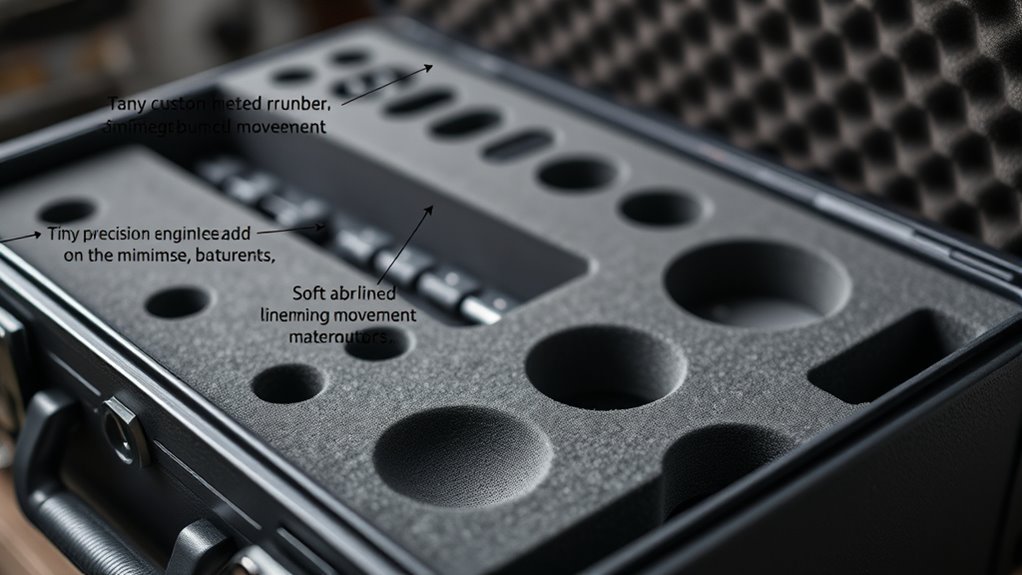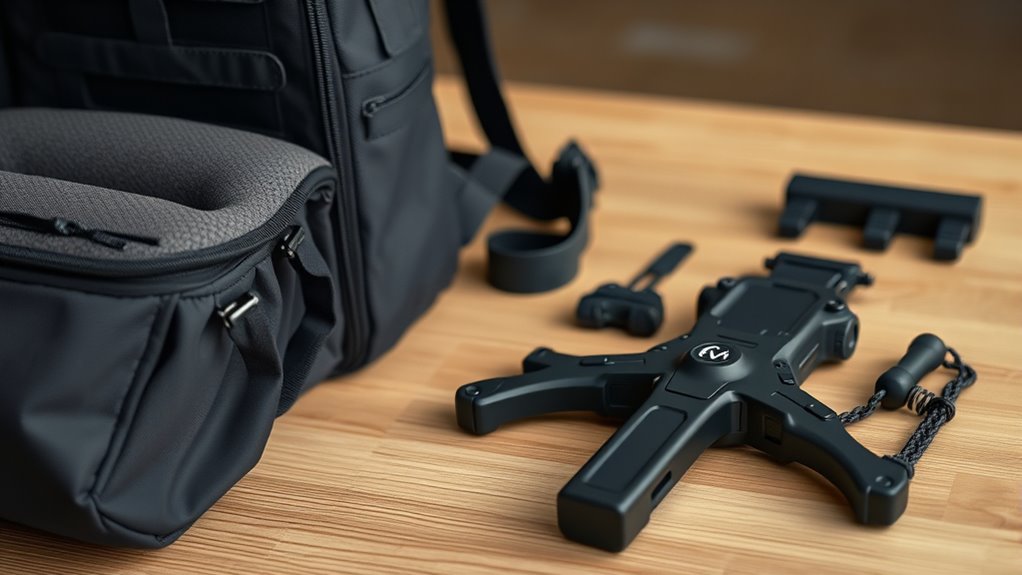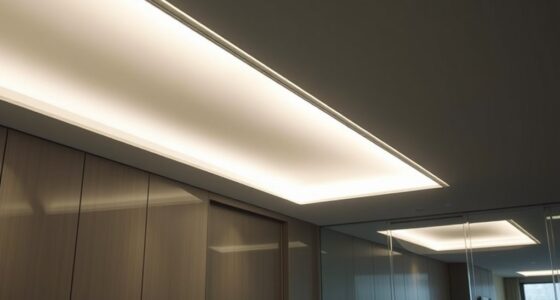To eliminate clanking and minimize noise, start with soundproofing materials like foam panels or mass-loaded vinyl to absorb sound and block transmission. Use vibration dampers or pads, especially under heavy equipment or shelving, to prevent rattles. Combining these approaches ensures a quieter workspace and less disturbance for others. Focus on pairing materials effectively, and you’ll considerably improve your setup. Keep exploring for more tips on creating the ultimate noise-free environment.
Key Takeaways
- Use sound-absorbing foam panels or acoustic mats on equipment surfaces to reduce sharp noises and echo.
- Install vibration dampers or pads on machinery legs to prevent rattling and clanking during operation.
- Combine soundproof materials like mass-loaded vinyl with vibration dampers for maximum noise isolation.
- Start with small upgrades such as rubber feet or foam strips, then scale up to more advanced damping solutions.
- Properly pairing materials and placement enhances noise reduction, creating a quieter, more comfortable environment.

Ever wonder how to enjoy your favorite activities without disturbing others? The key lies in understanding how to effectively reduce noise and eliminate clanking sounds. One of the most practical steps is to utilize soundproofing materials designed specifically to absorb or block noise. These materials can be applied to various surfaces, such as walls, floors, and even equipment, to prevent sound from traveling and creating disturbances. Foam panels, mass-loaded vinyl, and acoustic mats are popular choices that can markedly diminish the echo and sharp noises associated with many activities. By installing these, you create a quieter environment that still allows you to indulge in your hobbies without worry.
Another essential aspect is addressing vibrations that cause clanking sounds. Vibrations often lead to noise when equipment or objects rattle or clang against each other. To combat this, vibration dampers are your best allies. These small but effective devices absorb the energy from vibrations before they translate into noise. You can attach vibration dampers to the legs of machinery, shelving, or any equipment prone to movement. They work by converting the vibrational energy into heat or dispersing it, which prevents the sounds from becoming loud or disruptive. When paired with soundproofing materials, vibration dampers can make a noticeable difference in creating a more peaceful space.
The combination of soundproofing materials and vibration dampers provides a thorough approach to noise reduction. For example, if you’re setting up a recording studio or a workshop, lining the walls with soundproofing materials minimizes the transmission of noise outside or into neighboring rooms. Meanwhile, placing vibration dampers under heavy equipment prevents rattling and clanking during operation. This dual strategy not only enhances your comfort but also respects the peace of others around you. It’s a smart way to enjoy your activities, whether it’s playing music, working on DIY projects, or practicing sports, without the constant worry of disturbing your household or neighbors.
Implementing these solutions doesn’t have to be complicated or expensive. Start small by adding foam panels or rubber pads under equipment. Over time, you can upgrade to more advanced soundproofing materials and specialized vibration dampers tailored to your specific needs. The effort pays off with a quieter environment, allowing you to focus better, enjoy your activities longer, and maintain good relationships with those nearby. With the right combination of soundproofing materials and vibration dampers, you’ll find it easier than ever to keep the noise down while still having a great time. Additionally, understanding soundproofing techniques can help you optimize your setup for maximum noise reduction and comfort.
Frequently Asked Questions
How Do I Identify Noisy Gear Components?
To identify noisy gear components, start with a thorough gear inspection, listening carefully for unusual sounds during operation. Check for signs of component wear, such as cracks, corrosion, or looseness, which can cause rattling or clanking. Move parts gently to feel for excessive play or movement. By closely examining and testing each part, you can pinpoint the culprit and determine whether it needs lubrication, repair, or replacement to eliminate noise.
Are DIY Modifications Effective for Noise Reduction?
Think of your gear as a symphony of moving parts, sometimes out of tune. DIY soundproofing and gear vibration damping can be your tuning tools, effectively silencing unwanted noise. These modifications transform clanking chaos into a whispering breeze, proving that with a bit of effort, you can craft a quieter, smoother ride. Yes, DIY tweaks often provide a practical, cost-effective way to reduce noise and improve your gear’s performance.
Which Materials Best Absorb Sound in Gear?
When choosing materials for gear, you want to focus on soundproofing techniques that absorb sound effectively. A material comparison shows that dense foams, like open-cell foam, excel at dampening noise, while mass-loaded vinyl provides excellent soundproofing. You should consider adding these materials to your gear to minimize clanking and improve quietness. Experimenting with different layers and combinations helps you find the best setup for your needs.
Can Noise Reduction Affect Gear Performance?
Noise reduction can improve your gear’s performance by using soundproofing techniques and noise dampening materials. These methods minimize distractions and vibrations, helping your gear operate more smoothly and quietly. When you incorporate sound-absorbing materials, you reduce clanking and unwanted noise, which can enhance accuracy and efficiency. Overall, applying effective noise dampening strategies guarantees your gear functions better, providing a quieter, more controlled environment for your activities.
How Often Should I Maintain Quiet Gear Modifications?
Think of your quiet gear modifications as a delicate garden needing regular tending. You should stick to a consistent maintenance schedule, inspecting and re-tuning as needed, typically every few rides or months. This routine helps preserve modification longevity and keeps noise reduction at its peak. Neglecting maintenance risks the silent harmony turning into clanking chaos, so stay vigilant and proactive to make certain your gear remains a whisper-quiet companion on every adventure.
Conclusion
By choosing the right materials and mods, you can silence your gear just like a whisper in a library. Think of it as tuning your setup into a smooth, peaceful ride where clanking is replaced with quiet confidence. Implementing these tips is like turning down the volume on chaos, letting you focus on the game or work without distraction. With a little effort, your gear will become as silent as a shadow, giving you the calm and focus you need.










